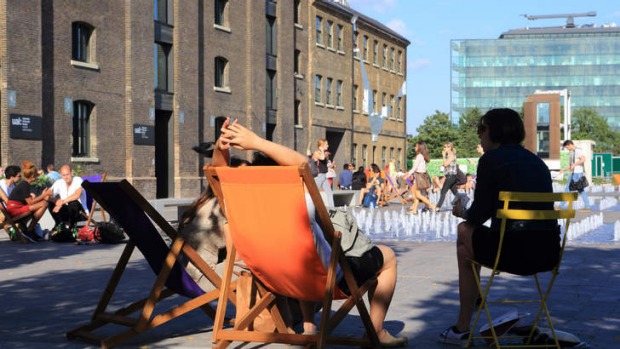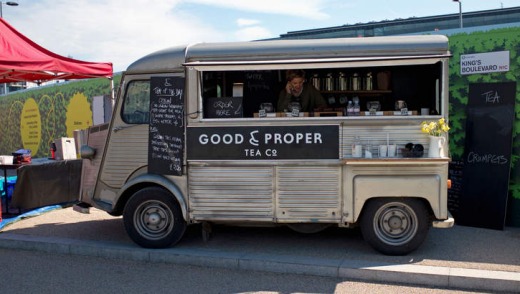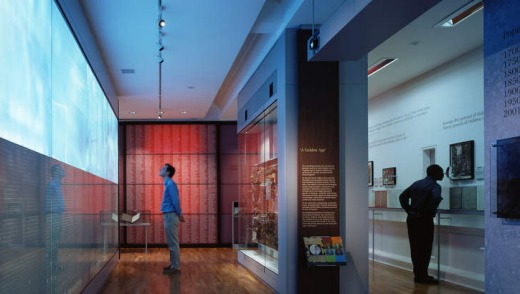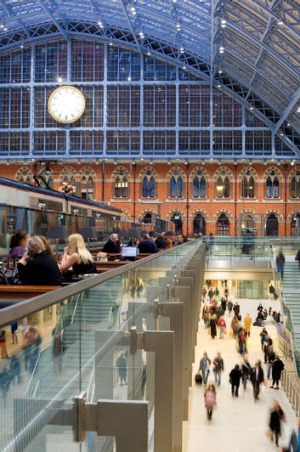
A once down-at-heel area represents the new, fabulous London, writes Julietta Jameson.
Central London's Caledonian Road, or the Cally, as it's known for short, has seen some stuff: drug trade and prostitution, violent family feuds and murder.
Sandwiched insalubriously between Holloway and Pentonville prisons, it was, for the latter part of the 20th century, overrun with disenfranchised "yoof" who gave the Ethiopian shopkeepers more than a hard time.

Fast forward to 2013: once squatter-infested terraces are selling for well over £1 million ($1.7 million), flats for more than £400,000. The menace of the Cally has been replaced by a gentrified bohemianism. While still edgy, it's now home to students and arty types side by side with executives on its Georgian rows and cobbled offshoots.
The Cally's upward swing is symptomatic of what's going on in its neighbourhood, the Kings Cross area, generally. Kings Cross is the new fab London and it's only going to get more fabulous. Huge regeneration is under way to rival that of Docklands.
Kings Cross to the north of London was actually rural through to the mid-17th century. It was a place of health spas and country inns dotting pastoral beauty.

Then the Euston Road was built and in came industrial-revolution development. Big polluters arrived, most notably the Gas Light and Coke Works. There were warehouses for coal and potatoes and, with the completion of the Regent's Canal and enormous Kings Cross and St Pancras stations, it became a place of goods yards, warehousing, refuse sorting and paint production. Poor quality digs for the workers followed.
In the post World War II years, freight transport by rail declined.
By the end of the 1980s, the rail lines were gone and the old industrial buildings fell into dilapidation. But the construction of the Channel Tunnel Rail Link between London and Paris and the 2007 opening of St Pancras International terminus at the heart of the area began an extraordinary cultural shift. The revitalisation of beautiful St Pancras station as the terminus also included a reimagining of the old railway hotel therein. In addition to hotel space, it included apartments and the likes of the pop star Lily Allen took up residence.

Concurrently, 745,000 square metres of industrial wasteland was earmarked for its own reimagining. Planning permission was granted in 2006. Since then, it's a project that's galloping along.
With 20 new streets, 10 new squares, 23 new and refurbished office buildings (including the huge new London HQ for Google), loads of shops, restaurants and amenities and 2000 new homes to be built, there's a way to go. But there's already plenty of exciting things, new and old.
At the heart of it all is the Granary. Once a store of Lincolnshire wheat for London's bakers, it's now home to the University of Arts London and the famed Central Saint Martins, a school that boasts alumni such as Stella McCartney and Alexander McQueen. Inside is a series of spaces with glass walls built around a covered "street", including exhibition spaces and workshops. It has been pivotal to the optimism about the overall development, as it's brought in life, youth and fashion - in other words, instant street cred.
The new Kings Cross Visitors Centre is housed here. In front of it is elegant Granary Square, which is spectacularly laid out with 1000 choreographed lit fountains spouting up from the ground. Able to accommodate 2000 deckchairs, it's home to festivals and performances and is the size of Trafalgar Square. Opened mid-2012, it's already a hit with Londoners and is really quite beautiful, with historic buildings around three sides and to the fourth, sweeping stairs leading down to Regent's Canal.
The canal is also pivotal to the area's increasing beauty - many of its attractions sit along it, such as Kings Cross Filling Station. An abandoned canal-side petrol station was taken by the scruff of the neck by some clever architects and turned into a temporary restaurant and exhibition and event space. Shrimpy's restaurant, the main tenant, was a mega-hit when it opened in 2012. Its terrace, open in the warmer months, is what to go for - but be quick. The whole place gets knocked over next year as part of the redevelopment. (kxfs.co.uk). Not going anywhere is the imposing Fish and Coal Offices, an evocative brick complex that hugs a tight bend in the canal. They were quite handsome in their run down, decaying form. But soon they'll sparkle as offices and studios with canal-fronting restaurants on the ground floor.
It's worth seeking out the London Canal Museum; the former ice warehouse dating from the 1860s is on a charming little waterway cul-de-sac between York Way and Caledonian Road . Nearby, another quirky little museum, the Foundling Museum in the 1739 Foundling Hospital, has a lovely cafe on site as well as providing exhibitions focused on art and the plight of vulnerable children .
Kings Boulevard is the first of the new streets to emerge from the redevelopment. The main thoroughfare at Kings Cross linking St Pancras to Granary Square and the area north of Regent's Canal, the leafy walk is home to an excellent market, KERB, a mouth-watering collective of hand-picked street food vendors.
Ribs, mussels, meringues, doughnuts, hot dogs and hamburgers . . . it's all gourmet and usually served from a cute, uniquely designed wagon and good for a casual London lunch on the cheap. In times to come, it will flow with office workers and residents once all the surrounding new buildings are occupied. See kerbfood.com.
Even if you're not off to Paris on the Eurostar, while in the area it's worth visiting grand and wonderful St Pancras station. Looking at its intricate neo-Gothic Victorian facade that inspired J.K. Rowling, it's hard to believe it was almost knocked down in the 1960s.
Inside, be sure to pay homage at the witty statue of Poet Laureate John Betjeman, who mounted the campaign to save it.
Afterwards, do take a walk up the Cally. A great landmark to head for is Housmans, a "radical" not-for-profit bookstore that's been going strong since 1945 selling publications focused on progressive politics. And later, stop by one of those Ethiopian restaurants. Locals love Merkato for its authenticity.
The writer was a guest of Qantas, Accor Hotels and Visit Britain.
GETTING THERE
Qantas has a fare to London for about $1780 return from Sydney and Melbourne including tax. Fly to Dubai (about 14hr) and then to London Heathrow (7hr 50min); see qantas.com.au.
STAYING THERE
The Pullman London St Pancras is a modern, bright four-star next to the British Library and three minutes' walk from St Pancras Terminus. It has had a £10 million ($17 million) makeover. 100-110 Euston Road. Rooms from £190. Pullmanhotels.com.
TRIP NOTES
MORE INFORMATION
Kingscross.co.uk; visitbritain.com.